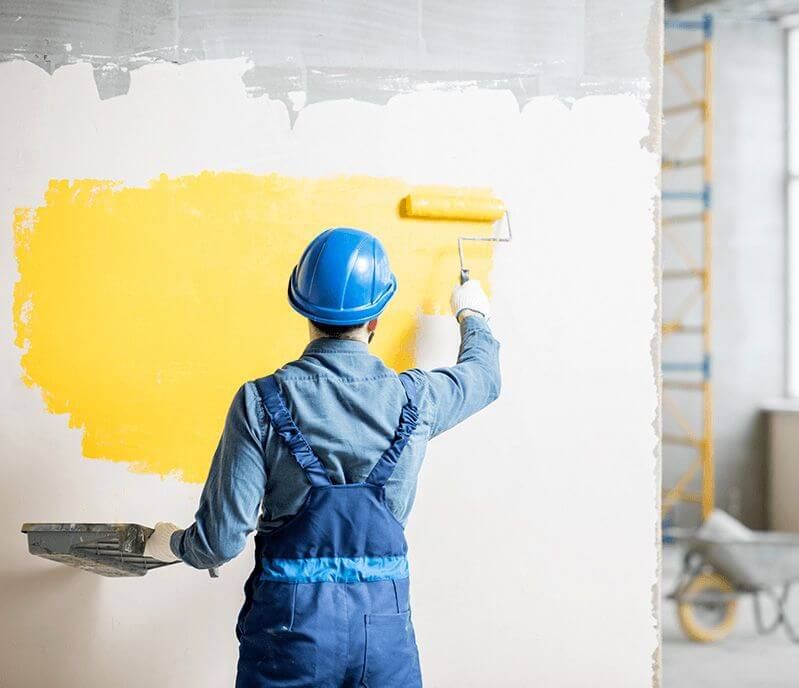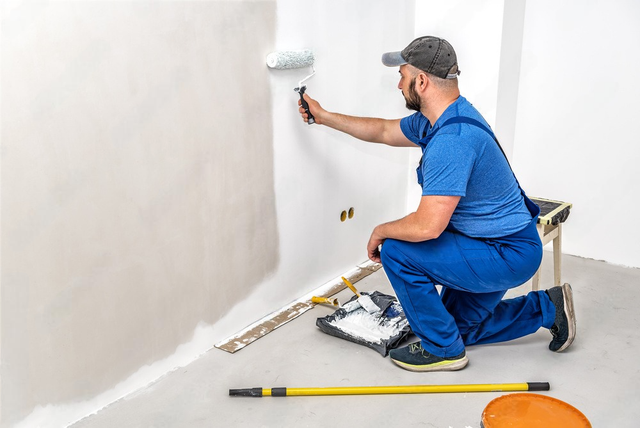Exploring the Different Kinds Of Paint: An Overview for each Project
Exploring the numerous sorts of paint is essential for attaining the preferred result in any task. From water-based choices that provide benefit to oil-based paints known for their resilience, each choice has its qualities. Specialized paints can add one-of-a-kind structures or surfaces, while green options satisfy those seeking sustainability. Understanding these differences can considerably affect the success of a paint venture. What elements should one take into consideration when making the ideal choice?
Recognizing Paint Types: Water-Based vs. Oil-Based
Paint kinds can considerably influence a job's end result, and comprehending the distinctions in between oil-based and water-based paints is important for educated decision-making. Water-based paints, typically described as latex paints, are composed of water as the main solvent. They dry promptly, release fewer unstable natural compounds (VOCs), and are simple to tidy up with soap and water. This makes them a popular choice for indoor applications and environments where air high quality is a problem.
On the other hand, oil-based paints utilize natural solvents, providing a resilient, shiny coating ideal for surfaces subjected to tear and wear, such as trim and cupboards. They take longer to completely dry, require mineral spirits for clean-up, and have a more powerful smell. paint shops in corpus christi. Picking in between these 2 types depends upon the details demands of the project, considering aspects such as wanted coating, application setting, and ease of maintenance. Each type has unique advantages and restrictions, assisting the option process
The Complete Issues: Picking In Between Matte, Satin, and Gloss
When picking a paint coating, the selection in between matte and glossy choices considerably influences both aesthetics and functionality. Matte finishes offer a subtle, non-reflective look that can hide surface area blemishes, while shiny coatings give durability and ease of cleansing. Recognizing the advantages and factors to consider of each can assist in making an informed decision for any paint job.
Matte Complete Benefits
Numerous house owners dispute the advantages of various coatings, matte paint uses unique advantages that make it a popular choice for both indoor and exterior applications. One of the key benefits of matte coating is its ability to hide surface area imperfections, developing a smoother appearance on wall surfaces. This high quality is particularly beneficial in older homes or spaces with irregular surfaces. In addition, matte paint takes in light as opposed to showing it, which can boost the visual of a space by giving a much more sophisticated and soft appearance. Matte finishes are usually much easier to touch up than glossier options, as they can blend extra perfectly when used over existing paint. Generally, matte paint is an excellent option for those looking for a refined and sophisticated coating.
Glossy Finish Considerations
A glossy coating can drastically modify the perception of an area, using a streamlined and reflective quality that enhances both color vibrancy and light within a space. This coating is often favored for high-traffic areas and surfaces like bathroom and kitchens, where longevity and ease of cleaning are vital. Nevertheless, its reflective nature can highlight blemishes on wall surfaces, making correct surface preparation vital. Shiny paints additionally often tend to reveal smudges and fingerprints quicker, demanding normal upkeep. In addition, illumination plays a considerable function; in brilliant atmospheres, a glossy finish may create glow, influencing the total visual. Cautious consideration of the specific application and setting is crucial when selecting a glossy coating for any kind of job.
Specialized Paints: When to Use Distinctive or Chalk Paint
Specialized paints, such as textured and chalk paint, offer unique visual and functional benefits that can boost numerous surfaces. Distinctive paint is excellent for developing deepness and measurement on walls, hiding flaws while adding a three-dimensional feeling. It is particularly beneficial in high-traffic locations where toughness and visual passion are necessary.

Both kinds of specialty paints can transform areas, however choosing the best one depends on the desired effect and surface area needs. Distinctive paint might fit bigger areas, while chalk paint can revitalize smaller sized things, showcasing imagination and personal style in any project.
Exterior Paints: Shielding Your Surface Areas From the Aspects
Outdoor paints are important for safeguarding surfaces versus different climate condition. Recognizing their weather condition resistance features, correct surface prep work needs, and efficient application methods can greatly boost toughness and performance. This area will outline key considerations for picking and using exterior paints successfully.
Weather Resistance Includes
Weather condition resistance is a necessary feature of exterior paints, as it identifies just how well surfaces can hold up against the severe components of nature. Top quality outside paints are formulated to resist damages from UV rays, wetness, and temperature level fluctuations. UV resistance assurances colors stay vibrant with time, protecting against fading and discoloration. Wetness resistance safeguards versus mold and mildew and mildew, which can compromise the stability of surface areas. Additionally, paints with excellent temperature resistance can contract and increase without fracturing, maintaining their safety qualities. When try this out choosing outside paints, it is crucial to take into account these weather condition resistance features, as they contribute to the long life and sturdiness of painted surface areas, ensuring they remain cosmetically pleasing and functional in spite of direct exposure to the components.
Surface Prep Work Requirements
Proper surface preparation is a fundamental step in accomplishing the ideal outcomes with exterior paints. To guarantee perfect attachment and longevity, surface areas must be thoroughly cleaned, removing dust, mold, and oil. This can be accomplished utilizing a pressure washing machine or a scrub brush with a suitable cleaning service. Once cleaned, surface areas must be checked for any peeling or flaking paint, which must be scraped away to develop a smooth structure. Fixing any type of cracks or holes is likewise vital, as these can enable moisture seepage. In addition, fining sand rough areas advertises far better paint attachment. Applying a guide fit for outdoor usage can boost the paint's efficiency, ensuring a long-lasting coating that endures the elements. Appropriate prep work is crucial to an effective outside paint job.
Application Techniques Tips
While using outdoor paints, it is vital to make use of efficient methods that guarantee surface areas are well-protected against the aspects. Pick the appropriate day for painting; low moisture and moderate temperatures improve bond and drying. Prepping the surface thoroughly-- cleansing, sanding, and priming-- ensures far better paint adhesion and durability. Utilizing top quality brushes or rollers can give a smoother surface, while spray paint might cover big locations efficiently. Using paint in slim, also coats avoids runs and drips. It is advisable to comply with supplier instructions navigate to this website relating to drying out times between coats. Confirm correct air flow during application to help with drying and decrease exposure to fumes. These methods substantially boost the longevity and effectiveness of outdoor paint.
Eco-Friendly Options: Low-VOC and Zero-VOC Paints
As customers become increasingly familiar with the environmental effect of their choices, low-VOC and zero-VOC paints have emerged as popular options. These paints are developed to have less unpredictable natural substances (VOCs), which are chemicals that can vaporize right into the air and add to air contamination and wellness troubles. Low-VOC paints typically include a restricted quantity of VOCs, while zero-VOC paints have minimal levels, making them much safer for both indoor and outside use.
The benefits of making use of zero-voc and low-voc paints prolong beyond ecological factors to consider; they additionally improve indoor air top quality, decreasing the threat of allergic responses and respiratory system issues. Numerous manufacturers currently supply a variety of colors and surfaces in environmentally friendly options, making it less complicated for customers to find ideal products for their tasks. By going with these paints, individuals can add to a healthier environment while still attaining the aesthetic they desire in their rooms.
Tools and Techniques for a Remarkable Application
Achieving a flawless paint application calls for the right tools and strategies, which can considerably enhance the outcome. Picking the proper brush or roller is vital; brushes work well for sides and complex areas, while rollers cover bigger surface areas effectively. Making use of high-grade materials assures better paint circulation and reduces touches. For perfect outcomes, surface prep work is necessary. This includes cleansing, fining sand, and priming surface areas to promote bond.
Technique also plays a significant function. The "W" technique with a roller aids to uniformly disperse paint, while long, smooth strokes with a brush protect against visible lines. Operating in areas enables much better control and mixing. Additionally, using thin layers is preferable to thick layers, decreasing the threat of drips and irregular textures. Lastly, keeping a wet side throughout application aids attain seamless changes between areas. By incorporating these methods and devices, one can achieve a polished and professional surface.
Tips for Keeping and Taking Care Of Your Painted Surfaces
Proper maintenance and care of painted surfaces can greatly extend their life-span and protect their appearance. Normal cleansing is essential; using a soft towel or sponge with moderate soap and water can eliminate dust and dirt without damaging the paint. It is recommended to stay clear of unpleasant cleansers or rubbing pads, as these can damage the surface area. In addition, using a fresh coat of paint every couple of years can invigorate the shade and secure versus wear.
For outside surfaces, examining for signs of peeling off or fading routinely is necessary. Without delay resolving any type of problems prevents further damage. In areas vulnerable to dampness, such as restrooms, using mold-resistant paint and ensuring correct ventilation can aid maintain the integrity of the paint. Lastly, using safety surfaces can shield versus UV rays and stains, making sure that repainted surfaces continue to be attractive and vibrant for several years to come, inevitably improving the general aesthetic of the room.
Often Asked Concerns
Can I Mix Different Types of Paint Together?
Mixing different kinds of paint is typically not recommended, as it can cause problems like bad adhesion, inconsistent texture, or unexpected chemical reactions. It's best to utilize suitable paints for excellent outcomes and durability.

Exactly how Do I Effectively Store Leftover Paint?
To effectively keep leftover paint, secure the container tightly, label it with the date and shade, and keep it in a great, dry location far from direct sunshine and severe temperatures for optimal conservation.
What Is the Ideal Means to Take Care Of Extra Paint?
The ideal means to throw away unused paint is to examine local policies, as numerous look at this now areas have assigned harmful waste facilities. Conversely, take into consideration contributing useful paint to community organizations or schools for their jobs.
Just How Can I Inform if Paint Is Still Great to Utilize?
To figure out if paint is still great, examine its color, uniformity, and scent. If it appears apart, has an undesirable odor, or shows significant changes in structure, it's most likely no more functional.
Exist Age Restrictions for Getting Paint Products?
In several areas, there are no particular age restrictions for acquiring paint items. Nevertheless, some stores might require consumers to be at the very least 18 years old, especially for products containing solvents or hazardous products.
Paint types can markedly affect a job's outcome, and recognizing the differences in between water-based and oil-based paints is crucial for notified decision-making. Water-based paints, often referred to as latex paints, are made up of water as the key solvent. In contrast, oil-based paints make use of organic solvents, supplying a durable, shiny coating suitable for surface areas exposed to use and tear, such as trim and cabinets. Specialized paints, such as distinctive and chalk paint, offer special visual and functional advantages that can improve numerous surfaces. In areas susceptible to dampness, such as bathrooms, utilizing mold-resistant paint and ensuring proper ventilation can help keep the stability of the paint.